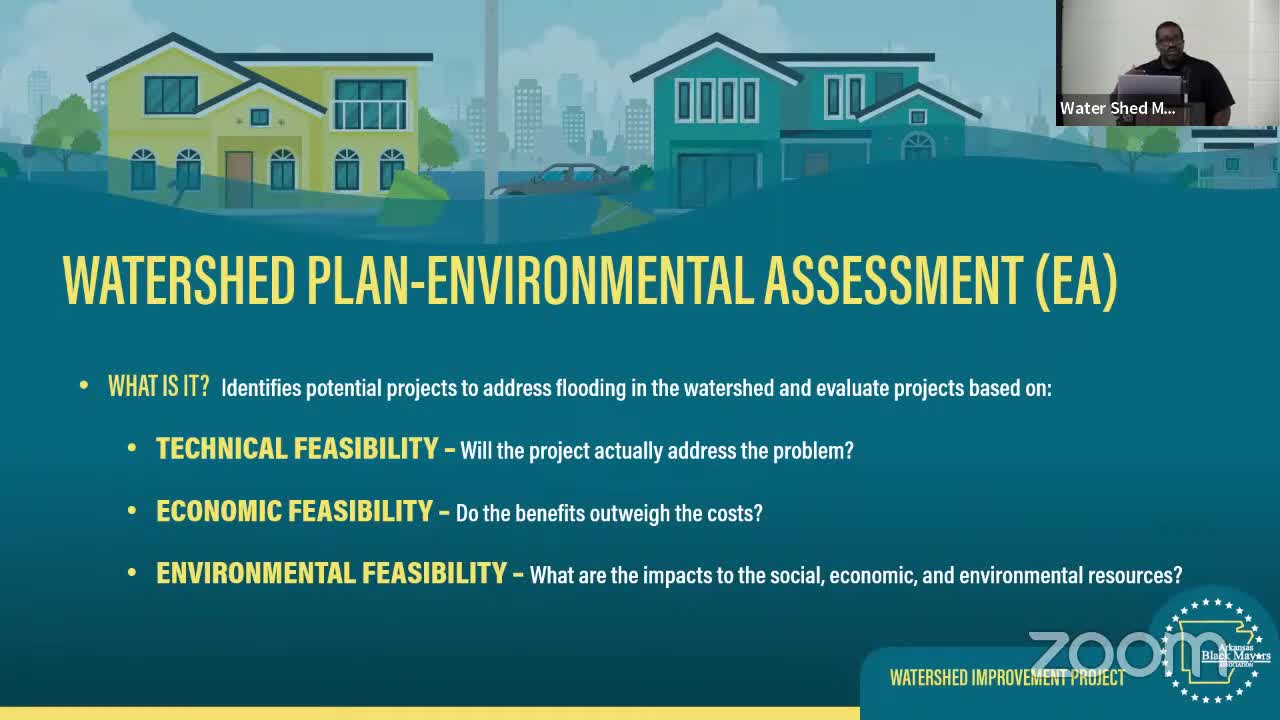Engineering Team Unveils Draft Watershed Plan for Flood Management Projects
September 22, 2024 | Helena, Phillips County, Arkansas
This article was created by AI summarizing key points discussed. AI makes mistakes, so for full details and context, please refer to the video of the full meeting. Please report any errors so we can fix them. Report an error »

In the heart of Helena-West Helena, city officials gathered on September 21, 2024, to discuss the future of local watersheds, a topic that resonates deeply with residents concerned about flooding and drainage issues. The meeting served as a platform for sharing the draft Environmental Assessment (EA) of the watershed plan, inviting public feedback to refine the proposed projects aimed at mitigating flooding risks.
The session began with a recap of the watershed planning process, which commenced with a Preliminary Investigation Feasibility Report (PIFR) conducted by a previous firm. This initial phase laid the groundwork for understanding the flooding challenges faced by the community. As the meeting progressed, officials emphasized the importance of public input, noting that comments gathered throughout the planning stages have been instrumental in shaping the draft plan now under review.
Kelly, a key speaker at the meeting, highlighted the transition from planning to design, a phase that will soon follow the approval of the draft EA. Residents expressed eagerness to see tangible progress, asking when construction would begin. While officials acknowledged that the timeline remains uncertain, they assured attendees that the design phase would involve detailed surveys and assessments, which may lead to adjustments in project scope based on real-world conditions.
A significant focus of the discussion was the scoring rubric used to evaluate potential projects. This rubric considers various factors, including the severity and frequency of flooding, as well as social conditions and environmental justice. The aim is to ensure that the selected projects not only address immediate flooding concerns but also promote public health and economic stability.
Aaron, a representative from Olsen, a consulting firm involved in the project, introduced a "story map" that visually outlines the proposed projects and their intended impacts. This interactive tool allows residents to engage with the planning process more directly, providing a clearer understanding of how each project fits into the broader watershed strategy.
As the meeting drew to a close, officials reiterated their commitment to transparency and community involvement. The draft EA is now available for public review, and feedback is encouraged to refine the plans further. With the stakes high for local residents, the outcome of this watershed planning process could significantly influence the future resilience of Helena-West Helena against flooding.
The session began with a recap of the watershed planning process, which commenced with a Preliminary Investigation Feasibility Report (PIFR) conducted by a previous firm. This initial phase laid the groundwork for understanding the flooding challenges faced by the community. As the meeting progressed, officials emphasized the importance of public input, noting that comments gathered throughout the planning stages have been instrumental in shaping the draft plan now under review.
Kelly, a key speaker at the meeting, highlighted the transition from planning to design, a phase that will soon follow the approval of the draft EA. Residents expressed eagerness to see tangible progress, asking when construction would begin. While officials acknowledged that the timeline remains uncertain, they assured attendees that the design phase would involve detailed surveys and assessments, which may lead to adjustments in project scope based on real-world conditions.
A significant focus of the discussion was the scoring rubric used to evaluate potential projects. This rubric considers various factors, including the severity and frequency of flooding, as well as social conditions and environmental justice. The aim is to ensure that the selected projects not only address immediate flooding concerns but also promote public health and economic stability.
Aaron, a representative from Olsen, a consulting firm involved in the project, introduced a "story map" that visually outlines the proposed projects and their intended impacts. This interactive tool allows residents to engage with the planning process more directly, providing a clearer understanding of how each project fits into the broader watershed strategy.
As the meeting drew to a close, officials reiterated their commitment to transparency and community involvement. The draft EA is now available for public review, and feedback is encouraged to refine the plans further. With the stakes high for local residents, the outcome of this watershed planning process could significantly influence the future resilience of Helena-West Helena against flooding.
View full meeting
This article is based on a recent meeting—watch the full video and explore the complete transcript for deeper insights into the discussion.
View full meeting
